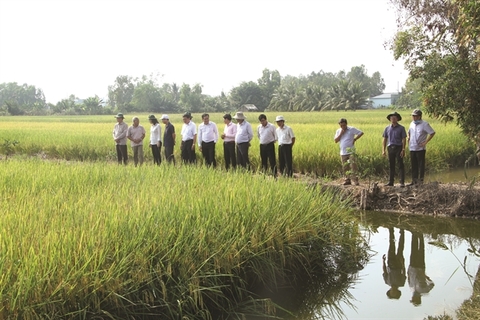 |
|
Harvesting the 2020-21 winter-spring rice in Tien Giang Province’s Go Cong Dong District.
|
Nguyen Van Man, director of the province’s Department of Agriculture and Rural Development, said that the coastal districts of Go Cong Dong, Go Cong Tay and Tan Phu Dong, and Go Cong Town will grow only winter-spring rice and summer-autumn rice, and no longer grow autumn-winter rice.
In the autumn-winter crop, the coastal districts and Go Cong Town will grow other short-term crops resistant to saltwater intrusion and drought.
In 2021-25, the districts and Go Cong Town will also convert 3,290ha of rice fields in areas without access to irrigation water resources to fields growing crops like vegetables, fruits, perennial trees, and grasses for feeding animals.
To provide support for these changes, the province has completed various construction projects, transferred intensive-farming techniques, and expanded new effective farming models that adapt to climate change.
Farmers have been encouraged to use advanced techniques like “three increases-three reductions” and “one must and five reductions” in rice cultivation, and grow rice and other crops under Vietnamese or global agricultural practices (VietGAP or Global GAP) standards.
The "three increase-three reductions” technique reduces the use of seedlings, fertilisers and plant-protection chemicals in an aim to improve productivity, quality and efficiency.
The "one must and five reductions" technique refers to the use of certified seeds and reduction in plant-protection chemicals, nitrogenous fertilisers, irrigation, seedlings and post-harvest losses.
The province also plans to build more transport and irrigation projects to serve production and transport of farm produce. It will set up specific cultivation schedules for rice and other crops in order to use water efficiently and prevent pollution.
Tien Giang is one of the delta’s coastal provinces most severely impacted by climate change, especially saltwater intrusion in the dry season.
Success with new crops
Man said to cope with climate change and natural disasters, the province since 2016 has reduced rice cultivation and restructured crops in the coastal districts of Go Cong Dong, Go Cong Tay and Tan Phu Dong, and Go Cong Town.
In 2016-20, the province restructured crop cultivation on more than 32,500ha of rice fields, which was 57 per cent higher than the province’s target set for the period.
Of the 32,500ha of rice fields, nearly 5,500ha no longer grow summer-autumn rice, and nearly 21,000ha stopped autumn-winter rice cultivation. About 6,000ha no longer grow rice and instead grow other high-value short-term crops and perennial trees.
Compared to rice growing, the profit from growing perennial trees has been two times higher than rice and profit from vegetables three times higher, according to the department.
Dang Anh Phuong in Go Cong Dong District’s Phuoc Trung Commune turned his 5,000sq.m rice field in a coastal area into a lime orchard and now earns an income of VND30 million (US$1,300) a month from selling harvested limes.
“The profit is about 10 times higher than from growing high-quality rice,” he said.
VnSAT Tien Giang
The Vietnam-Sustainable Agriculture Transformation (VnSAT) project in Tien Giang Province (VnSAT Tien Giang) since 2015 has helped rice farmers increase income by 34 per cent, according to VnSAT Tien Giang’s management board.
Pham Van Trong, deputy chairman of the province’s People’s Committee, said that VnSAT Tien Giang helped rice farmers apply advanced technologies and protect the rural environment.
VnSAT Tien Giang, which has an investment of $12.38 million, is being implemented on a total area of 27,200ha of rice with the participation of 41,015 farming households in the province’s flood-prone districts of Cai Be and Cai Lay and Cai Lay Town in the 2015-21 period.
It has provided advanced rice farming techniques called “three increase-three reductions” and “one must and five reductions" to more than 108,000 farmers to improve production efficiency, and has instructed farmers in how to apply good agricultural practices standards.
It has also upgraded eight rural roads with a total length of 19 kilometres, and built six rural bridges, 10 water regulation sluices, four water regulation sluices with pumping stations, seven warehouses, and four rice dryer houses.
Under VnSAT Tien Giang, farmers have applied "three increase-three reductions” on more than 17,000ha and “one must and five reductions” on more than 8,200ha, exceeding the project’s targets for the 2015-21 period.
Under VnSAT Tien Giang, the province has established 19 agriculture co-operatives and one co-operative group. Of these, 16 agriculture co-operatives have farm contracts with rice companies to grow rice on large-scale rice fields.
This year, VnSAT Tien Giang will organise 36 courses to train more farmers in "three increase-three reductions” and “one must and five reductions”, and build 10 agriculture infrastructure works at a total cost of VND95.5 billion ($4.1 million).
The VnSAT Project is being implemented in all five provinces in the Tay Nguyen (Central Highlands) region and eight provinces in the Mekong (Cuu Long) Delta by the Ministry of Agriculture and Rural Development in co-operation with relevant ministries and the World Bank.
The project aims to enhance the competitiveness of the agricultural sector, especially rice and coffee cultivation, improve farmers’ incomes, and reduce adverse impact on the environment.
VNS

'Nature - based' farming a winner in Mekong Delta
All of the delta’s 12 provinces and its major city, Can Tho, have been able to turn more unproductive rice fields into fruit tree and other crop...

Seasonal organic rice revival in Mekong Delta
According to the analysis by QY Research published in 2020, the total value of global organic rice exports in 2018 was US$1.5 billion.